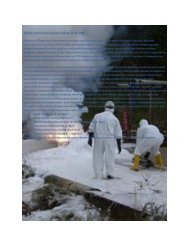Toxic Gas Monitoring Systems â Design & Integration One Approach ...
Toxic Gas Monitoring Systems â Design & Integration One Approach ...
Toxic Gas Monitoring Systems â Design & Integration One Approach ...
You also want an ePaper? Increase the reach of your titles
YUMPU automatically turns print PDFs into web optimized ePapers that Google loves.
<strong>Gas</strong> Detection<br />
<strong>Gas</strong> <strong>Monitoring</strong> Locations – HPM cabinet exhaust:<br />
• <strong>Gas</strong> cabinets<br />
• VMBs<br />
• <strong>Gas</strong> isolation boxes (GIBs) / <strong>Gas</strong> Pods<br />
• Tool cabinet gas box<br />
• Vacuum pump housings<br />
• Any exhausted enclosure containing un-welded fittings of HPM gas.<br />
• Sensor placements (diffusion or extractive) should be located up in the<br />
exhaust duct (not inside the cabinet) to consider mixing and duct airflow<br />
behavior – to ensure ideal gas leak detection.<br />
▫<br />
▫<br />
If possible – locate sensor 4 duct diameters downstream from the source<br />
cabinet.<br />
Locations should be upstream (below) any isolating mechanical blast gate (as<br />
should exhaust ventilation differential Pressure or airflow sensors).<br />
• Extractive sample tubing should extend at least 2” into the exhaust duct.<br />
2012 NE SESHA Conference




